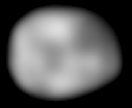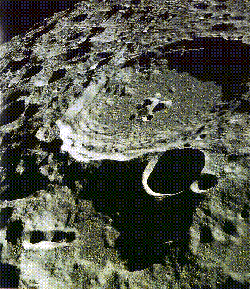Asteroids and Meteoroids
Asteroids are small lumps of rocks and ice which orbit the Sun like mini-planets. They are sometimes called planetoids because they were probably formed in the same way as the planets.
It is believed that the Solar System formed from a huge cloud of swirling gas and small rocky particles. Most of the cloud was attracted to the centre to form the Sun, whereas smaller amounts formed the Gas Giants and even smaller amounts formed the Inner Planets. As the clumps of very small rocky particles (smaller than dust) joined together with other clumps, they increased in size, until they had gathered together to form the planets as we know them. Asteroids are believed to be formed in the same way, except that they did not get attracted to bigger masses of rock to form part of a planet. Instead, they stayed relatively small and orbit the Sun as planetoids or minor planets. Some asteroids have the characteristics of planets. Vesta (shown in the blurry picture below) is an asteroid which is known to have ancient lava flows on it. This shows that the asteroid had a molten centre, like Earth has, and like planets like Mars and Venus once had (and possibly still do have). All asteroids also spin on their own axis, just like stars, planets and moons.

Between the orbits of Mars and
Jupiter is an area called the Asteroid Belt. This is where the largest collection
of asteroids orbiting the Sun are. Hundreds of thousands of asteroids, none with a diameter (width) of over 1,000 kilometres (with
Ceres
being the biggest), and only sixteen of them over 240 km, spin around the
Sun. Occasionally they collide with each other, and may, one day,
in millions of years, all join together to form another Earth-sized planet. The Solar System is constantly developing, and the Asteroid Belt
may be a planet still in production.
Similar to asteroids, but even smaller, are meteoroids. These are lumps of metal and rock that fly through space. They could be parts of planets, moons or asteroids chipped off them during collisions, or debris from comets. They fly through space, hitting planets and leaving impact craters, as seen on the surface of Mars, the Moon and Mercury. Below is a picture of craters on the Moon's surface (this is from the far side of the Moon - the side we never ever see from Earth. It was taken by Apollo 11 astronauts in 1969 while in orbit of the Moon).

All planets with solid surfaces have craters on them. Even Earth, with its thick protective atmosphere which burns up most meteors headed in its direction, has huge craters. In fact, because it is the biggest of the four inner planets, it is the planet most targeted by meteors (its size is greater and it has a stronger gravitational pull). Its atmosphere burns up most incoming meteors, and craters that have formed on the planet are often covered up by the planet's constant (but slow) geological processes of reforming itself. The first crater to be recognised as being one from a meteorite impact was the Barringer Crater, in the state of Arizona, USA, shown below.
